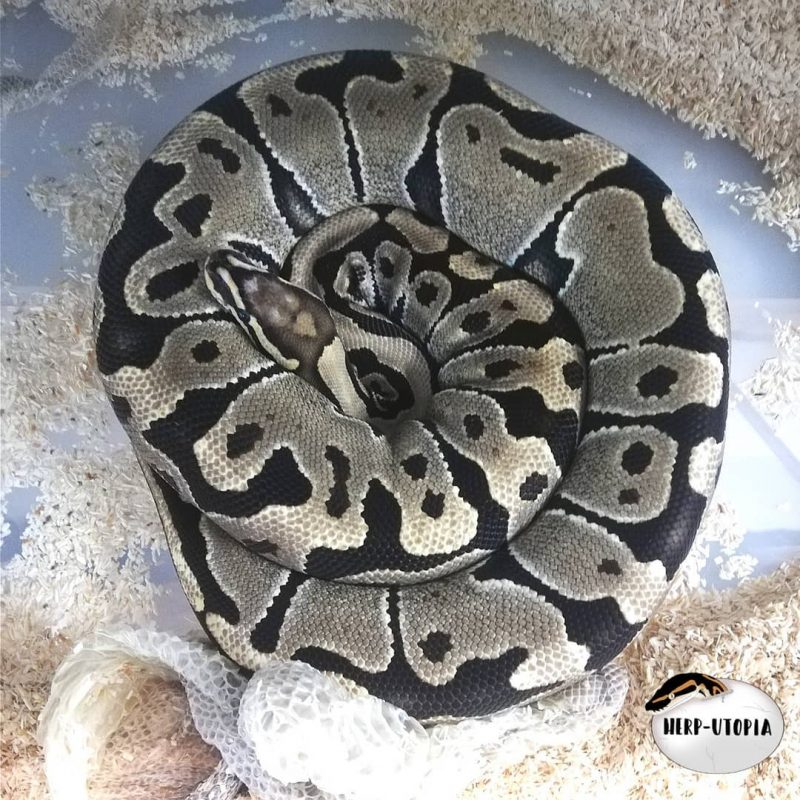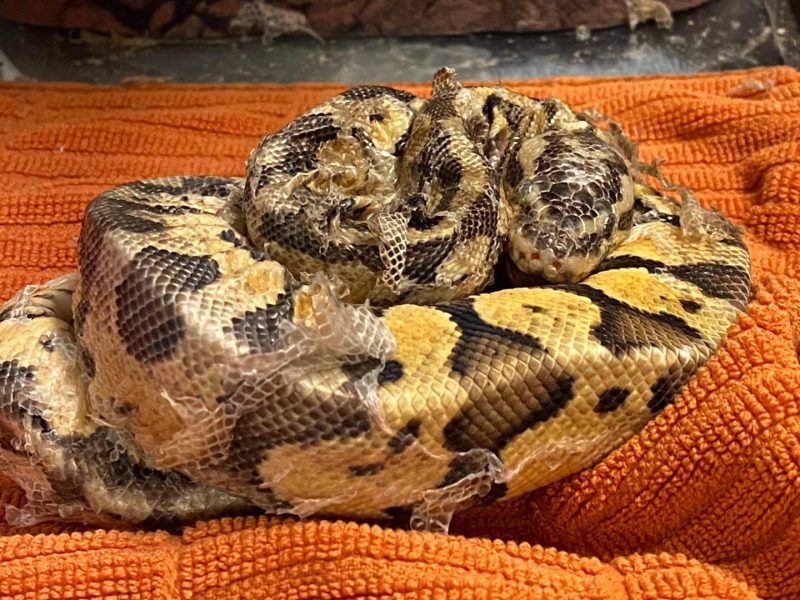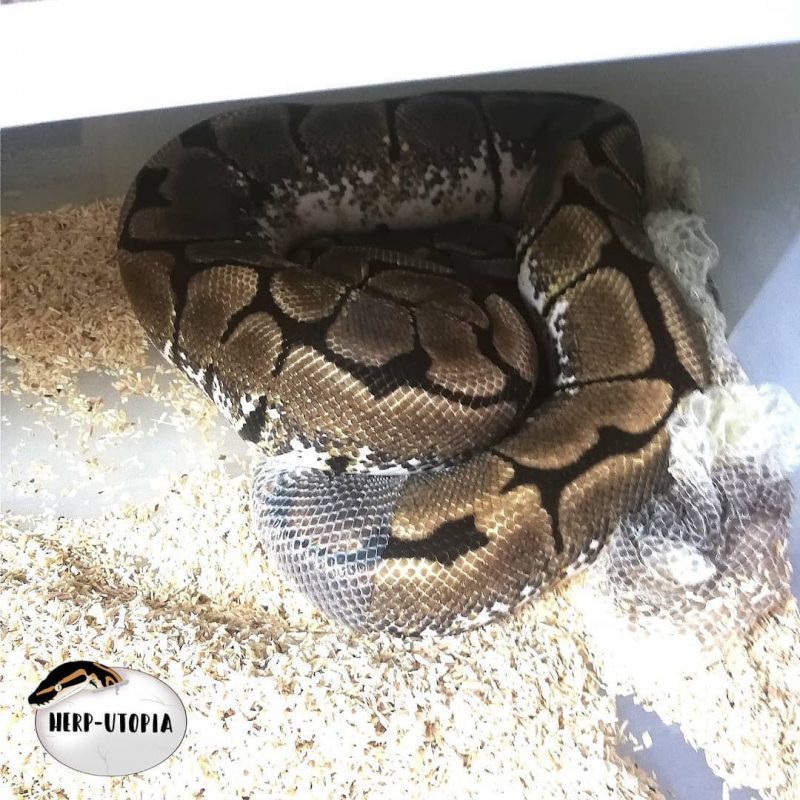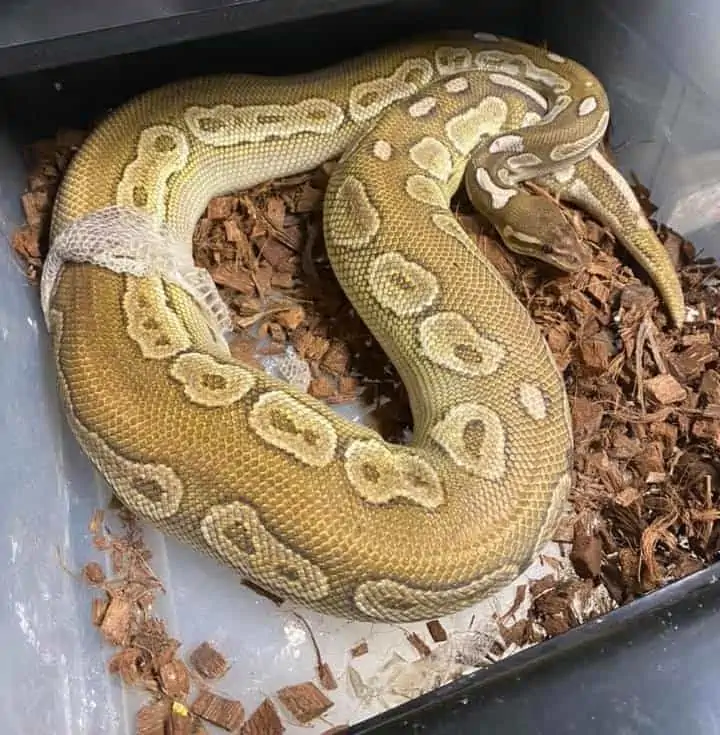Photo Courtesy of Ocmulgee Reptiles
How Long Does It Take a Ball Python to Shed?
As with all snakes, a healthy ball python will shed its entire top level of skin in one piece. This occurs every 4 – 6 weeks in adults and more regularly in juveniles. The full process from the beginning of slough to the skin actually coming off takes between 10 – 14 days. The blue phase of shedding lasts for 2 – 4 days and leads to the skin shed itself which takes around 10 minutes.
The greyish blue color of your snake and the milky appearance of its eyes are caused by a lubricant that builds up between the top layer of skin and the new skin underneath. This liquid is vital to your snake having a successful shed, so make sure your snake has access to a moist hide. Also, check that your temperature and humidity levels are correct.
Can You Handle a Ball Python While It’s Shedding?
As soon as you first notice that your snake’s skin is becoming dull and it is entering into a slough, you should stop handling your snake until after it has completed shedding. Oils on our hands can affect the lubricant under the top layer of our python’s skin and cause problems with shedding. During these few days, your ball python will also likely become agitated, and with their reduced vision, there is an increased risk of a bite occurring.

Should I Feed My Ball Python While Shedding?
During shedding, most snakes will refuse food and if fed, they sometimes regurgitate the item. Whilst feeding dead food items to your snake during this time won’t do it any harm, we recommend waiting until after it has shed to avoid wasting food items. We would never recommend live feeding captive snakes but for those that do, feeding during slough puts your snake at serious risk of damage from the prey item.
How Long After My Ball Python Shed Should I Feed Him?
It is safe to feed your snake as soon as it has finished a successful shed. In fact, you are likely to find that after shedding your snake’s mood will return to normal and he/she will be hunting around for food.
> Further reading: The Ball Python Diet
Why Is My Ball Python Constantly Shedding?
Juvenile snakes shed as often as every 3 weeks as they outgrow their old skin. If your juvenile snake is shedding more often than every 3 – 4 weeks or your adult snake is shedding more often than every 4 – 6 weeks, this could be a sign that something is wrong.
Snakes will shed regularly if they are suffering from parasite infestations such as mites or ticks. Ticks are usually easy to spot and can be removed with tweezers, be sure to remove the entire body and head, leaving no parts still attached to the snake. Snake mites are very small and usually black in color. They live under the scales, causing scales to appear raised.

In order to cure a mite infestation, you will need to remove all substrate and furniture from your snake’s enclosure. Discard the substrate and pour boiling water over your wood furniture and thoroughly sterilize any plastic furniture. Keep your snake on a paper towel or newspaper until the infestation is cured. You will need to use a plastic or cardboard hide to prevent reinfestation during the treatment process. Gently wipe down your snake with frontline spray. Be careful of sensitive areas such as eyes, nose, and mouth (always wear gloves as frontline can have adverse health effects on humans).
> Further reading: Our Ball Python Health and Behavior Article
Another cause for your snake to shed more regularly than usual is scale rot. Scale rot is a term used to describe any bacterial or fungal infection causing sores, blisters, or decay of your snake’s scales and skin. All of these can result in the death of your snake and require immediate and effective treatment. If your snake is suffering from scale rot, certain scales will appear deformed, discolored, or blistered.
Determining whether an infection is caused by bacteria or fungus is the first stage. This may sometimes take a veterinarian to distinguish, however, bacteria is the most common cause of scale rot. The first treatment should be betadine baths twice a day and Neosporin cream (without pain relief). Refer to our article on ball python scale rot for more details. If the infection has not begun to clear up after 3 days, consult your veterinarian.
Scale rot has a number of causes but the most common causes are improper regulation of temperatures and humidity, unsanitary living conditions, or less commonly vitamin deficiencies. Feces should be removed from your python’s enclosure regularly and complete substrate change and disinfection of the enclosure should also be carried out monthly.
Take a look at our ball python temperatures and humidity article for further information on how to maintain them properly.

Why Does My Snake Not Shed in One Piece?
If your snake does not shed in one complete piece, he or she may require some extra help to remove skin that has gotten stuck. Incomplete shedding can be caused by incorrect temperature and humidity regulation, skin conditions, or handling during the shedding process. Your python should have access to a moist hide in order to aid the shedding process. If the skin does become stuck, bathe your snake in lukewarm water for 15 minutes, if skin still remains attached to your snake, gently try to remove it by hand. If this still does not work, use shedding aid to assist with removal. Some snakes may require an increase in humidity during the blue phase of shedding, however, it is important not to raise the humidity too high or for too long as this can have a detrimental effect on your snake’s health.
I hope you found this article helpful, if you have any further questions, please check out the linked articles in the text or write your question in the comments below.



One Comment
Excellent information and advice!!! Thank you!